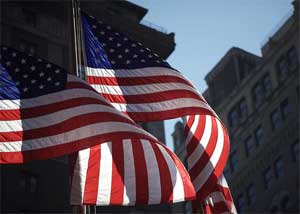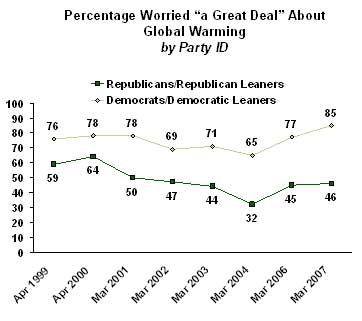 Since it came out about a year ago, An Inconvenient Truth, Al Gore’s climate change documentary, seems to have pushed the issue into mainstream consciousness.
Since it came out about a year ago, An Inconvenient Truth, Al Gore’s climate change documentary, seems to have pushed the issue into mainstream consciousness.
Millions saw the movie itself — but they were largely true believers anyway. Perhaps more importantly, Gore’s Academy Award has earned him a wider audience among the potentially undecided: 39.9 million TV viewers tuned in for the Academy Awards themselves, plus 49 million saw Gore on Oprah. Heck, combined, that’s more than the total number of people who voted for George W. Bush in 2006! It’s almost as good as being on American Idol.
But, how much effect has this media blitz had on attitudes among Americans?
Sadly, it’s not as dramatic as you may think.
According to Gallup’s annual environmental survey, conducted this month, there’s a decent increase in Americans who report they are highly concerned, “from 36 to 41 percent since this time last year — building on a 10-point increase that occurred between 2004 and 2006.”
But that still only brings us to 2000 levels:
The percentage now worried a “great deal” about global warming is only back up to the all time high — 40 percent — seen in April 2000.
The 2000 numbers came on the heels of a high-profile debate over the Kyoto global warming international protocol during the Clinton administration. Overall concern fell from 40 percent in 2000 to 33 percent shortly after George W. Bush took office in 2001.
And that’s just the point. An issue that should transcend politics has become increasingly partisan.
What’s most revealing about the 2007 Gallup numbers is a stark partisan divide — a growing rift that’s been dubbed the “Two Americas” by Framing Science guru Matthew Nisbet. According to the poll:
- 85 percent of Democrats are very concerned about global warming — up from 76 percent in 1999.
- Only 46 percent of Republicans share that level of concern. And that’s down from 59 percent in 1999 — a 13 percentage point drop, during a time when evidence for climate change kept piling up.

Not surprisingly, the split is reflected in national leadership as well. As of February of this year, according to a National Journal poll (PDF), 95 percent of Democrats in Congress said they believe it’s been “proven beyond a reasonable doubt that the earth is warming because of man-made problems.” Only 13 percent of Republicans in Congress said they believe this.
Nonetheless, we can likely thank former-future-president of the United States Gore, at least in part, for some encouraging gains.
- Americans’ knowledge about climate change has risen steadily. Three-quarters of Americans now say they understand the issue either very well or fairly well. (Compared to 53 percent in 1992 — and gaining 6 points during Gore’s climate campaign).
- Close to 6 in 10 (59 percent) Americans believe the effects of global warming have already started — five points up since 2005.
- Public concern about the environment in general shows an eight-point increase in concern since Gore took his show on the road.
- Only 19 percent believe the effects will be postponed to future generations (still too many), but just 8 percent still believe the effects of global warming will never materialize — a bump up from numbers I recently reported here.
- Sixty-one percent blame human activities for climate change; 35 percent attribute changes to natural causes (numbers largely unchanged since Gore’s campaign began).
However, while Gore may have stirred up the choir and hauled a few stragglers on board, it’s unlikely he’s the man for the tough job of reuniting these two Americas to combat what he recently described to Congress as a “planetary emergency.” It may require an especially charismatic Republican leader — or more from the likes of Oprah — to do that.
 Since it came out about a year ago,
Since it came out about a year ago, 

